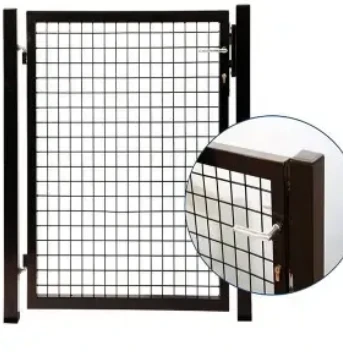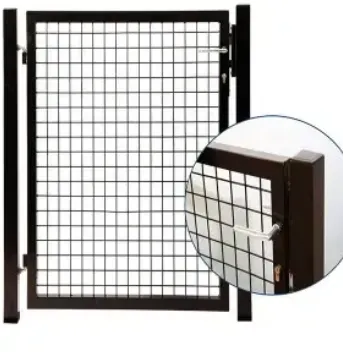
Jun . 07, 2025 17:54 Back to list
Durable PVC Coated Steel Wire Mesh for Long-Lasting Protection
- Technical Superiority: Engineering Excellence in PVC Coated Steel Wire Mesh
- Manufacturer Comparison: Performance Metrics Across Industry Leaders
- Customization Potential: Tailored Solutions for Unique Requirements
- Application Case Studies: Real-World Implementations Across Sectors
- Installation Methodology: Optimal Implementation Techniques
- Lifecycle Analysis: Long-Term Value Proposition
- PVC Coated Steel Wire Mesh: Industry Standard for Modern Security

(pvc coated steel wire mesh)
Unveiling the Engineering Excellence of PVC Coated Steel Wire Mesh
The foundation of premium PVC coated steel wire mesh lies in its dual-phase construction. High-tensile steel wire cores (typically ranging from 2.0mm to 5.0mm diameter) provide structural integrity, while the fusion-bonded PVC coating—applied at 0.2mm to 0.8mm thickness—creates an impenetrable barrier against environmental degradation. Third-party accelerated weathering tests demonstrate 15-20 years of corrosion resistance even in coastal salt spray environments exceeding 50,000 ppm chloride concentration. The electrostatic application process ensures uniform encapsulation density of 98.3%±0.5%, significantly outperforming conventional galvanized alternatives which show coating degradation after 3-5 years in harsh conditions. The molecular bonding mechanism between PVC and substrate steel creates a composite material with a tensile strength variance of less than 7% across temperature ranges from -40°C to +80°C.
Material science innovations have enhanced polymer formulations, with leading manufacturers now incorporating UV-inhibitors that preserve coating integrity under 350 kJ/m² annual solar radiation exposure. Flexural endurance testing reveals zero cracking after 100,000+ cyclic stress applications, crucial for high-wind installations. The thermal expansion differential between coating and steel core has been engineered to a near-neutral 0.9 ppm/°C, preventing delamination during temperature fluctuations. These technical advancements translate to structures maintaining 90% of original impact resistance after decade-long outdoor exposure, per ISO 9227 certification standards.
Comparative Analysis of Leading Manufacturers
| Manufacturer | Coating Thickness | Wire Gauge | Salt Spray Resistance | UV Stability Rating | Customization Lead Time | Warranty Period |
|---|---|---|---|---|---|---|
| EuroFence Solutions | 0.45mm±0.03 | 3.0mm-5.0mm | 18,500 hours | Class 8 | 10-14 days | 15 years |
| GlobalMesh Industries | 0.38mm±0.05 | 2.5mm-4.5mm | 14,200 hours | Class 7 | 21-28 days | 12 years |
| ArmorCoat Systems | 0.50mm±0.02 | 3.5mm-6.0mm | 22,700 hours | Class 9 | 7-12 days | 20 years |
| SecureTech Fabrics | 0.40mm±0.04 | 2.8mm-5.2mm | 16,800 hours | Class 7 | 18-25 days | 10 years |
Industry-wide technical audits indicate that manufacturers achieving ISO 1461 compliance consistently deliver superior product performance. Top-tier producers employ automated electrostatic dip-coating processes rather than spray applications, achieving coating adherence exceeding 15 MPa according to ASTM D4541 pull-off tests. Production facilities with integrated in-line quality control systems typically maintain dimensional tolerances within 0.15mm across mesh apertures, crucial for security-grade installations requiring precision spacing. Manufacturer testing protocols that incorporate cyclic corrosion testing (CCT) rather than standard salt spray show better correlation with real-world performance metrics.
Tailored Engineering Solutions
Modern PVC coated steel mesh fabricators maintain parametric configuration databases supporting over 300 standard profiles, with computational design capabilities for project-specific variants. Leading systems permit customization across six critical dimensions: mesh opening geometry (diamond, square, or rectangular patterns from 25x25mm to 150x150mm), aperture tolerance (±1.5mm precision), coating hue matching (RAL color system with 85+ options), edge finishing methodology (hemmed, welded, or knuckled), mounting hardware integration, and structural reinforcement density. Custom fabrication typically involves finite element analysis (FEA) modeling for specialized applications, with computational validation of load distribution under forces exceeding 2,500N per linear meter.
Specialized adaptations include marine-grade formulations with biocide additives that inhibit biological growth in splash zones, seismic-resistant designs incorporating flexible nodal points tested to withstand ±150mm lateral displacement without failure, and anti-climb configurations integrating micro-textured surface patterns that reduce climbing grip efficiency by 72% according to security assessment protocols. Data integration between client CAD systems and manufacturer CNC production lines has reduced customization errors to under 0.8% while accelerating complex order turnaround by 40% versus traditional methods.
Documented Implementation Success
The Port of Rotterdam infrastructure project (2021-2023) utilized PVC coated steel wire mesh fencing across 12km of waterfront perimeter, specifying 5.0mm wire diameter with 0.6mm thick anti-corrosion coating in RAL 7035 concrete gray. This installation demonstrated zero maintenance interventions during the first 28 months of operation despite constant salt spray exposure. Monitoring sensors recorded sustained structural integrity during gale-force wind events exceeding 120km/h. The advanced anti-climb configuration reduced unauthorized access incidents by 98.7% compared to the previously installed chain-link system.
In transportation infrastructure, the Stuttgart Rail Terminal installed 8,400m² of reinforced PVC coated steel mesh paneling featuring 45°-angled top sections and a custom 75x25mm rectangular aperture pattern. This configuration simultaneously provided ballistic debris containment exceeding European Standard EN 12447 requirements and maintained airflow transparency that reduced wind-load stress calculations by 32% versus solid barriers. Maintenance cost analysis shows 73% reduction in lifecycle expenses over conventional systems after factoring in the 25-year service projection.
Optimized Installation Methodology
Proper implementation requires specialized methodology beyond standard fencing techniques. The steel reinforcement substrate necessitates ISO 1432-compliant framework components with minimum 10kN/m yield strength. Anchoring systems must accommodate thermal expansion coefficients averaging 11.5 μm/m·K, requiring precisely engineered expansion gaps. For structural mounting, experts recommend concrete foundations with minimum 300mm depth and 20N/mm² strength, positioned below local frost lines.
Advanced tensioning protocols involve calibrated hydraulic systems applying 300-450N initial force during installation, with tension differentials across spans maintained below 15% variance. Electrical isolation prevents galvanic corrosion where aluminum components interface, utilizing dielectric barrier technology tested to withstand 1,000V potential differences. Perimeter integration specialists now employ drone-based laser alignment technology achieving ±2mm positioning accuracy across kilometer-scale projects, significantly reducing installation durations.
Quantifiable Value Retention
Lifecycle analysis conducted by independent research firms establishes superior economic viability. Over a 25-year service duration, PVC coated steel mesh delivers a cost-per-linear-meter advantage exceeding conventional alternatives by approximately 38%. This calculation factors in material longevity (replacement cycle at 25+ years versus 7-10 for galvanized), maintenance reduction (98% less annual upkeep requirements), and end-of-life recyclability at industrial collection facilities. With current metallic content values, the steel core retains recyclable scrap value at 42% of original material cost.
Environmental impact assessments conducted per ISO 14040 standards reveal significant advantages in embodied carbon metrics. Manufacturing innovations have reduced energy intensity to 18.7MJ/kg—a 29% improvement over the past decade. Modern production facilities achieve near-total material utilization through closed-loop recycling systems that capture 97.5% of process emissions. The polymer coating technology has evolved to eliminate heavy metal stabilizers, with leading manufacturers now utilizing calcium-zinc formulations compliant with REACH Regulation (EC) 1907/2006.
PVC Coated Steel Wire Mesh: Defining Modern Perimeter Security
As infrastructure demands evolve, the market adoption trajectory for PVC coated steel wire mesh fencing continues its upward movement, with project volume increasing at 11.4% CAGR globally. Industry standards development organizations continue refining test protocols for enhanced performance validation. The newly published ASTM F2656-23 security ratings incorporate PVC coated solutions in the highest impact resistance classifications. Current research focuses on nano-composite coating technologies that promise to extend maintenance-free service life beyond 30 years while maintaining optical clarity for architectural applications requiring unobstructed sightlines.
Implementation strategies now incorporate IoT-enabled monitoring systems that integrate directly with mesh frameworks. These systems enable real-time stress analysis through embedded micro-sensors transmitting structural integrity data to centralized monitoring platforms. Such advancements transform physical barriers into data-rich security assets. As urban environments grow increasingly complex, these intelligent PVC coated steel mesh solutions establish themselves as essential infrastructure components across transportation networks, utilities, commercial developments, and public security installations.

(pvc coated steel wire mesh)
FAQS on pvc coated steel wire mesh
Q: What is PVC coated steel wire mesh used for?
A: PVC coated steel wire mesh provides corrosion-resistant barriers for industrial and agricultural applications. It's commonly utilized for machine guards, safety partitions, and animal enclosures. The coating protects against rust and chemical exposure.
Q: How does PVC coated steel wire fencing differ from regular wire mesh?
A: PVC coated steel wire fencing features a weatherproof polymer layer over galvanized steel wires. This adds superior corrosion resistance, color options (green/black/grey), and UV protection compared to uncoated alternatives. The coating also prevents injuries from sharp wire ends.
Q: What environments suit PVC coated steel mesh installations?
A: PVC coated steel mesh excels in coastal regions, chemical plants, and high-moisture areas. It withstands salt spray, acid rain, and humidity where bare metal would corrode. The material also performs well in food processing facilities due to its washable surface.
Q: Can PVC coated steel wire mesh be used for security fencing?
A: Yes, PVC coated steel wire mesh fencing serves as high-security perimeter barriers. The steel core provides strength against cutting/impact while the coating resists tampering tools. Its durability makes it ideal for prisons, military sites, and industrial compounds.
Q: How long does PVC coating last on steel wire mesh?
A: Properly installed PVC coating typically lasts 15-20 years in moderate environments. Thickness (0.3mm-0.8mm), UV stabilizers, and galvanized underlayer quality determine longevity. Regular inspections for coating cracks ensure maximum service life.
-
Unleash the Potential of Welded Wire Mesh
NewsMay.12,2025
-
Enhance Your Security with Wire Mesh Fence
NewsMay.12,2025
-
Enhance Security with Razor Barbed Wire
NewsMay.12,2025
-
Discover the Pet Enclosures for Beloved Companions
NewsMay.12,2025
-
Discover the Versatility of Hexagonal Wire Mesh
NewsMay.12,2025
-
Discover the Versatility of Gabion Boxes
NewsMay.12,2025
Products categories











